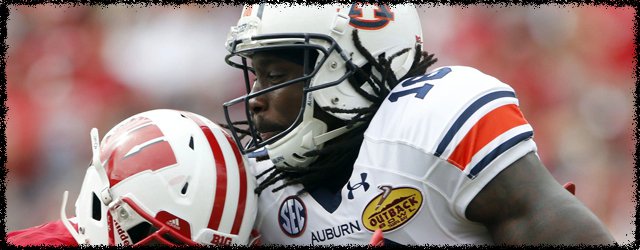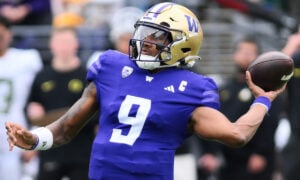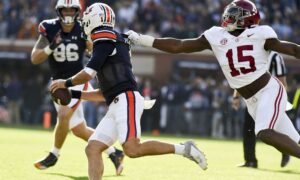Wide Receiver Combine Analysis: Part Three

If you’re an avid DLF premium reader, you’ve undoubtedly read both part one and part two of my analysis of the 2015 wide receiver class, using the NFL combine to quantify their athletic ability. If you haven’t read either of those, a chunk of this article won’t make any sense to you. If you want the full effect, go back and take a look at those.
Just to make life easier for you just, click here to see part one and click here to see part two. In order to check if all of this actually holds any water or is just a bunch of made up numbers, you can see my look back at the 2014 rookie class right here.
During those previous articles, I didn’t spend much (if any) time going over the top receivers in this draft class. Instead, I focused on the players who will be middle round or late round selections. Since the top receivers are the players with the most upside and also the highest price tag, they deserve a little special treatment. I’m going to address the players in order of their score according to the metric I’ve developed. I’ll share their score, their risk level in my opinion, the where I would start considering them, the DLF consensus ranking and where I personally rank each of them.
One item to keep in mind with receivers is of course the NFL draft. I’m not talking about the situation they find themselves in but rather where they are selected. The data is hard to dispute. Wide receivers drafted in the first round of the NFL draft (especially those in the first 5 or 6 picks) have a much, much higher rate of success than any other receivers. After the first round, there is very little correlation. Third round wide receivers aren’t any more likely to be successful than seventh round wide receivers. Any wide receiver who is drafted in the first round of the NFL draft probably needs to be bumped up a bit when compared to receivers not taken that early.
[am4show have=’g1;’ guest_error=’sub_message’ user_error=’sub_message’ ]
**I’ve included the score without height based measurements for each player. That way those people who feel height has no impact on success in the NFL can get an idea of their score without height factored into the equation.
Sammie Coates: 4.803, 4.367 without height
Risk Level: High
Where I would consider drafting him: Late First/Early Second
DLF Composite Ranking: 9th wide receiver
My Ranking: 8th wide receiver
The highest scorer of this year’s top ten wide receivers means Coates has the most complete package of physical attributes of the group. He is also one of the riskier wide receivers in this year’s draft class, which is why his ranking is towards the back end of the top ten. From a size perspective, Coates is almost the exact average. His 6’1” frame is right on the norm. He is a little bit more solidly built, has slightly smaller hands and slightly longer arms than the average, but all are very close.
Where Coates set himself apart from all of the others was with his performance in the drills. He ran a 4.43 second 40 yard dash, had a 41” vertical, 10’11” broad jump, 4.06 second time in the short shuttle and 6.98 second time in the three cone drill. The three cone drill is almost right on the average with his straight line speed being a little better and the others being significantly better. According to the drills, his explosiveness and acceleration are top notch, his straight line speed is more than good enough and his change of direction is also right where it should be when compared to the current fantasy producers.
On the field, Coates flashed all of this ability quite often. If you want to see some really nice highlight reel type catches, just check out some of the videos about him. He has the ability to leave defenders in the dust if they play him too tightly because he can out muscle them at the line and get past them. He also has the ability to make them pay if they give too much of a cushion by cutting sharply and using his acceleration to really take off. If someone manages to stay with him, he is bigger and stronger than most cornerbacks and can win at the point of the catch.
So, what is the problem with Coates?
After all, I only have him eighth and he is sounding like an early first right now. Receivers need to be able to catch the ball. Coates struggles with this at times. He body catches way too many passes and for every breathtaking catch he makes he lets an easy on go right through his hands or bounce off his pads. He also struggles a little bit tracking the ball in the air at times, which makes me think he lacks those natural receiver instincts which are so critical.
When you roll all of this together, you get a late first round lottery ticket. He could turn out to be what Torrey Smith was supposed to be or he could be the next Stephen Hill.
Amari Cooper: 2.323, 3.458 without height
Risk Level: Low
Where I would consider drafting him: 1.01
DLF Composite Ranking: 1st wide receiver
My Ranking: 1st wide receiver
Amari Cooper always has been and will continue to be my top wide receiver in this year’s draft class. I’m not saying he has the highest upside of this year’s group, because I don’t believe that is true. I’m just saying if I’m the owner of team which earned an early first round pick, I’m going with Cooper over any other wide receiver because he has such a high floor and terrible teams really can’t afford to miss on their early first round picks. As for me considering him at the 1.01, I’m not telling you to take him there, just that you need to think about it. The eventual landing spots for the rookies, their health, scoring system and several other factors need to be included to figure out who the best choice is going to be in your league. If you are going wide receiver, I’m going Cooper.
Cooper has a nearly identical build to Coates but with much larger hands and a bit shorter arms. Not only does he have a powerful build, but he uses that power to push defenders around and to create space when he needs it. In the drills, Cooper ran a very nice 4.42 second 40 yard dash to show he has more than enough speed for the position. His acceleration and change of direction abilities were very near elite levels with some of the best times in the shuttle and three cone drills. The only deficiency the combine showed was a lack of jumping ability.
If you watch him play the game, you see all of this. Cooper has the physicality to dominate all but the best cornerbacks. He has the speed, acceleration, quickness and route running to break ankles and leave defenders in the dust. He is very dangerous after the catch as well. There is a reason he has dominated at the college level for the last few years and will be a top ten pick in the NFL Draft. If you are going to nitpick, Cooper has had a few issues with drops, mostly due to lack of focus or trying to run before he has secured the catch. He also tends to play the position with his feet mostly on the ground, meaning he isn’t going up to make a lot of catches or skying over shorter defenders.
Ultimately, I think Cooper is a better, more athletic version of Sammy Watkins. Cooper also won’t be playing in Buffalo. I don’t think he will ever be a top five dynasty receiver, but I think he’s going to be a fixture in the second tier of wide receivers for a long time to come with about as little risk as you can find in a rookie.
Kevin White: 1.542, 0.867 without height
Risk Level: Moderate
Where I would consider drafting him: Early First
DLF Composite Ranking: 2nd wide receiver
My Ranking: 2nd wide receiver
If you go back to this time last year, Kevin White wasn’t even on the radar of most dynasty owners. After a highly productive year in West Virginia’s and an impressive combine, there are several who are talking about White being the first receiver drafted, both in the NFL draft and in fantasy leagues. While I’m obviously a believer in the combine telling us something about a player, it is just a piece of the puzzle. White’s combine is being a little overstated by several people. In fact, Cooper actually had a better overall combine. When you add in the fact that Cooper was better and has a longer track record, White is locked in as my second receiver.
In terms of physical measurements, White checked in at 6’3” and 215 pounds, which is obviously nearly idea size for the NFL. He also ran a 4.35 second time in the 40 yard dash at that size, which is why everyone went a little bit crazy after the combine. That is only a part of the picture though. He does have small hands and it might be part of the reason he struggled with drops his first year at West Virginia. The rest of his drills were right near the average of the baseline group, so not anything earth shattering but definitely good enough to succeed in the NFL as a top receiver.
Due to his size and speed combination as well as the growth he made during this last year, I think White has one of the highest upsides in this draft class. He could be one of the elites in a few years. Unfortunately, there is also quite a bit if risk with White. His 2014 stats might have been a little inflated by the system in West Virginia and he only had one year of good production. He also has a few holes in his game when it comes to the finer points of playing the wide receiver position. He could be great, but I think his chances of busting are significantly higher than Cooper’s chances. With that said, if White makes it out of the top four picks in any rookie drafts, it’s a crime.
Jaelen Strong: 1.450, 1.313 without height
Risk Level: Moderate
Where I would consider drafting him: Middle First
DLF Composite Ranking: 5th wide receiver
My Ranking: 4th wide receiver
Every year there seems to be a high quality receiver who gets over looked because they aren’t quite as flashy as some of the other players in their draft class. Last year it was Jordan Matthews. He wasn’t the most exceptional at anything, but he did everything better than most. As a result he slipped down draft boards and anyone who was lucky enough to pick him up has been rewarded with a player who definitely looks like they will be a very solid receiver in the NFL. He might never be elite, but he’ll help anchor a fantasy squad for years. This year that player is Jaelen Strong.
Outside of having small hands, Strong has very good size for the position. He ran the 40 yard dash in 4.44 seconds and was second only to the record breaking Chris Conley in the vertical leap. The size, speed, and leaping ability at the combine just confirm what you see when you watch Strong on the field. Unfortunately, he skipped the three cone drill and shuttle runs at the combine. I was really hoping to see how he did in those because there are some questions about his ability to change directions and his acceleration. If we use his pro day results (which is a bit of an apples to oranges comparison), the acceleration seems to be okay but his ability to change directions and keep his speed while doing so is a little lacking.
Strong has a lot to offer his future NFL team, including elite body control, but he needs to learn how to run his routes and sink his hips to get in and out of them much more cleanly. As it stands right now, Strong has to make an awful lot of contested catches because he struggles to separate some of the time due to the route running issues. Fortunately he wins most of these thanks to his leaping ability. The even better news is route running can be taught. I don’t think Strong will ever be a top 10 receiver in the NFL, but I think he has the ceiling of a very solid WR2 for your fantasy team with a pretty high floor in PPR leagues. While he lacks the upside of some others, he’s a very solid and fairly safe pick in the middle of the first round.
Devin Funchess: 0.234, -1.607 without height
Risk Level: High
Where I would consider drafting him: Middle Second
DLF Composite Ranking: 7th wide receiver
My Ranking: 10th wide receiver
As you can tell by my ranking compared to the general consensus, I’m not a huge fan of Funchess. If he was calling himself a tight end and expecting to play that position at the next level, he would be in the running for the top tight end in this draft class. Unfortunately for him, if he’s planning on playing wide receiver at the next level I don’t think it is going to work out for him.
As 6’4” and 232 pounds, Funchess has great size. He’s even pretty agile, especially given the size. However, he’s extremely slow to be playing outside receiver in the NFL. His 40 yard dash time of 4.7 seconds is just further proof of this. Not only is Funchess painfully slow for the position but his hands are rather questionable as well. He has far too many drops for someone who is supposed to be playing a possession receiver role. On the passes he doesn’t drop he allows them to get into his body much too often.
I think the best case for Funchess is to be drafted by a team with a need for a move tight end. If Funchess can add 10-20 pounds of muscle to his frame he can be a major match-up issue over the middle of the field. If he or his team are insistent upon him playing wide receiver I don’t think it is going to end well. There is a ton of risk with Funchess, and I think anyone drafting him might be drafting a tight end not a wide receiver – that’s why I’m not considering him until the middle of the second round.
That’s half of the top ten receivers in this year’s class and a few thoughts on each of them. Check back in a few days for the other half. Thanks for reading!
[/am4show]
- Final 2021 Pre-Draft Rookie Mock: Round Three - April 28, 2021
- Final 2021 Pre-Draft Rookie Mock: Round Two - April 26, 2021
- Final 2021 Pre-Draft Rookie Mock: Round One - April 25, 2021


































































